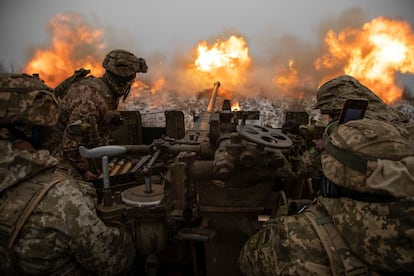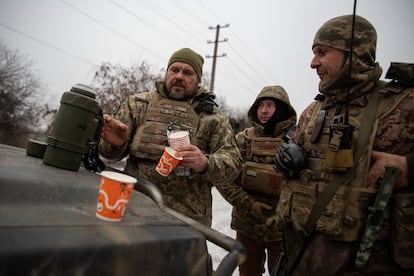A Red Bull and a smoke, then back to the front lines of Bakhmut
Ukraine is fiercely defending the besieged town and making Wagner’s Russian mercenaries pay a bloody price


Pallets loaded with every energy drink brand and flavor imaginable are stacked inside the only two working gas stations in Kostyantynivka, in Donetsk province, eastern Ukraine. A score of soldiers are lined up at the checkout counter with bags of energy drinks and cartons of cigarettes. They’re still in combat gear, with rifles slung over their shoulders and helmets in one hand. The Ukrainian troops refuel their vehicles and head back to the Bakhmut front, seven miles (11 kilometers) away. It’s one of the fiercest battles of the war, and Russia is hoping to claim its first military victory in six months after humiliating retreats last fall in the provinces of Kharkov and Kherson. But Ukraine has poured in reinforcements over the last week, and the Russian offensive led by the Wagner Group’s mercenary army has stalled.
The Ukrainian military deployment around Bakhmut is massive, but the exact size of the force is a closely guarded secret. EL PAÍS was reporting from the front lines around Bakhmut last week and didn’t see a single clump of trees or farm without an artillery unit, camouflaged fuel truck or tank company positioned within a mile of the Russian forces.
In every other battlefront, Ukrainian commanders prevent the news media from getting too close. But in Bakhmut, journalists can watch Soviet-era “Grad” rocket launchers fire rounds, NATO M777 howitzers moving into position, and a column of tanks taking a strategic hilltop. In Bakhmut, Ukrainian commanders are too busy to worry about journalists.
The battle for Soledar
On January 6, Christmas Eve for Orthodox Christians, Wagner mercenary units paid by the Kremlin launched a surprise assault on Soledar, a municipality north of Bakhmut. Except for its western edge, the town known for its salt mines was almost completely destroyed. Moscow claims to have full control of the area, but on January 15, a Ukrainian commander known as “Magyar” posted photos to social media of the Ukrainian flag flying over the Soledar salt mines.

EL PAÍS traveled the short, secondary road between Bakhmut and Soledar on January 14 and confirmed that the western flank of Soledar remains firmly in the hands of the Ukrainians. Nevertheless, these troops are preparing to fall back. Near the village of Krasna Hora between Bakhmut and Soledar, a truck was unloading anti-tank mines that would be placed to stop Russian tanks and infantry transport vehicles from advancing. About six miles (10 kilometers) away, the Ukrainians were establishing defensive tank positions near the road to Kramatorsk.
President Volodymyr Zelenskiy said on January 13 that all available reinforcements were being deployed to the area, and the Russian advance has indeed slowed in the past 72 hours. Ukrainian forces have even staged tactical counterattacks to reclaim a few patches of land in the eastern suburbs of Bakhmut. In many areas, it’s virtually hand-to-hand combat, and it can take days to take a single apartment block.
“The Russians are just 40 meters away in some places, which is something I haven’t seen before in this war,” said Roman (he prefers not to reveal his last name), a soldier from the 17th Armored Brigade who was posted to Bakhmut about six weeks ago. He wears a flak jacket packed with spare rifle magazines, and holds a Red Bull in one hand and a cigarette in the other as he takes a break to talk to us. Roman says that he now uses triple the amount of ammunition than when he first arrived in November.
A Russian artillery shell falls barely 50 meters from where we are standing, but unlike this reporter, he doesn’t flinch. Roman shouts when he speaks, just like the soldiers in Serhiy Zhadan’s The Orphanage (2021), a novel about the ongoing conflict in eastern Ukraine, who are half-deaf from all the battlefield explosions.
One of the most widespread reports last week that proved inaccurate was that the village of Krasna Hora had been taken by the Russians. According to open-source intelligence (OSINT) reports and Russian news agency TASS, Wagner mercenaries took Krasna Hora after Ukraine’s 17th Armored Brigade retreated. But EL PAÍS went to the edge of Krasna Hora and confirmed that there was no large-scale fighting, and that the town was still in Ukrainian hands.
Ammunition shortages
Soldiers from two battalions that had been stationed in Soledar and Bakhmut told EL PAÍS that they had to withdraw from the front lines due to ammunition shortages. Zelenskiy has also made public statements about this need. “Burshtin” (a pseudonym) is a tank commander with the 24th Mechanized Brigade who talked to us while taking cover behind a building in Bakhmut. Russian artillery shells rained down around us constantly. The Russian Ministry of Defense claims to have pushed back the 24th Brigade, but Burshtin says the real reason for their retreat was a lack of ammunition. Of the six tanks in his unit, only his own was still actively fighting.

Burshtin is only 25, but looks much older. His face is haggard from the exhaustion of sleeping inside his tank for over a month. He says they have killed waves of Wagner mercenaries and many convicts recruited from Russian prisons in exchange for reduced sentences.
“It’s a slaughter”
“It’s a slaughter,” said Bohdan Kihan, a soldier in the 77th Airmobile Brigade. “First, they send in the Wagner troops to gain a little ground and then the regular army brigades advance over all their corpses.” Thousands of miles away, Mick Ryan, a retired Australian Army officer and an oft-quoted analyst of the war in Ukraine, corroborated Kihan’s report. “In the battle of Bakhmut,” Ryan said on January 14, “the first waves of Russian troops are cannon fodder for other units that come in behind to occupy whatever ground has been gained.”
Kihan is 26 years old and limps from a shrapnel injury he suffered last fall. Although he’s not a believer, Kihan carries a rosary in a pocket of his flak jacket because a loved one gave it to him as a good luck charm. His commander relieved him from combat duty because of his injury, but Kihan wanted to get back into the action and was waiting with his comrades to board a transport vehicle at the road into Krasna Hora on January 14. The tiny village of 600 residents before the war was quiet as it dawned that morning, confirming to Kihan that “it’s still part of Ukraine.” He thinks that Russia has lost 10 soldiers for every Ukrainian in the battle for Bakhmut. US military sources estimated that as of November, Russia and Ukraine had a similar number of casualties – 100,000 dead and wounded on either side. But according to the Ukrainian high command, the brute-force Wagner offensive by expendable mercenaries has exponentially increased Russian casualties.
Burned-out vehicles
The two main roads connecting Bakhmut with the rest of unoccupied Ukraine were still open to traffic this weekend, despite several Russian and Ukrainian reports that said the road between Sloviansk and Bakhmut was impassable due to heavy Russian artillery. But EL PAÍS saw a steady stream of new Ukrainian armored vehicles and military equipment traveling the road toward Bakhmut. The road west to Kostiantynivka and Kramatorsk near Bakhmut is extremely dangerous, with Russian mortar shells screaming over cars racing to escape the fighting. The road is littered with burned-out vehicles that did not make it to safety.

Wagner’s platoons are just 2.5 miles (four kilometers) from the road in the village of Kurdiumivka, south of Bakhmut. It’s one of the furthest positions achieved by the Russian mercenary army led by Yevgeny Prigozhin. Were it not for all the death and destruction, the battle for Bakhmut would be like a thrilling game of chess. The Russians are trying to surround Bakhmut by attacking Soledar from the north and Kurdiumivka from the south. Meanwhile, the Ukrainians are trying to open a new front in Soledar, and are feeding in troops through Kramatorsk and Yampil.
At night, the sky over Bakhmut lights up like a macabre dance club as both sides launch non-stop volleys of artillery. Fifty miles (80 kilometers) away and out of range from Russia, are Ukraine’s HIMARS (High Mobility Artillery Rocket System) defenses, the most powerful artillery system in the war. Ukraine’s Ministry of Defense touts HIMARS as a sort of guardian angel, and only uses them at night to avoid giving away their location. The destructive force of HIMARS is unparalleled and has terrified Russian troops. In early January, the Ukrainian Armed Forces released a drone video of a building it blew up in Soledar with dozens of enemy soldiers inside. Kyiv also reported on January 12 that it had killed 100 Russians with a Tochka-U short-range ballistic missile also used by Russia.
Not many civilians have stayed in Bakhmut, and the few who remain rarely venture from their shelters. It’s estimated that only about 10% of Bakhmut’s pre-war population (73,000) is still in the area. Some stayed behind because they are pro-Russian, but others are elderly people who have given up on the future and just want to stay home, come what may. There are also some young people, like the woman who was playing her flute on the street with no one around to listen. Ukrainian military vehicles roared by, and constant explosions drowned out her music. She didn’t want to talk to us – she just wanted to be left alone to play, because “it’s what I like best.” She did tell us that her son was evacuated to Dnipro, 160 miles (260 kilometers) to the west and far from the battle. Why didn’t she leave? The woman wouldn’t say and just gave us a blank look, like someone who has already disconnected from reality.
Sign up for our weekly newsletter to get more English-language news coverage from EL PAÍS USA Edition
Tu suscripción se está usando en otro dispositivo
¿Quieres añadir otro usuario a tu suscripción?
Si continúas leyendo en este dispositivo, no se podrá leer en el otro.
FlechaTu suscripción se está usando en otro dispositivo y solo puedes acceder a EL PAÍS desde un dispositivo a la vez.
Si quieres compartir tu cuenta, cambia tu suscripción a la modalidad Premium, así podrás añadir otro usuario. Cada uno accederá con su propia cuenta de email, lo que os permitirá personalizar vuestra experiencia en EL PAÍS.
¿Tienes una suscripción de empresa? Accede aquí para contratar más cuentas.
En el caso de no saber quién está usando tu cuenta, te recomendamos cambiar tu contraseña aquí.
Si decides continuar compartiendo tu cuenta, este mensaje se mostrará en tu dispositivo y en el de la otra persona que está usando tu cuenta de forma indefinida, afectando a tu experiencia de lectura. Puedes consultar aquí los términos y condiciones de la suscripción digital.
More information
Archived In
Últimas noticias
Rowan Atkinson tops Netflix at 70: ‘He’s as funny as ever’
Israeli recognition of Somaliland stirs up the Gulf
Tiger Woods turns 50: Will he continue playing on the PGA Tour or take a back seat?
The surreal journey of James Nnaji, the Barcelona youth player selected in the NBA Draft who ended up in the NCAA
Most viewed
- Oona Chaplin: ‘I told James Cameron that I was living in a treehouse and starting a permaculture project with a friend’
- Reinhard Genzel, Nobel laureate in physics: ‘One-minute videos will never give you the truth’
- Sinaloa Cartel war is taking its toll on Los Chapitos
- Why the price of coffee has skyrocketed: from Brazilian plantations to specialty coffee houses
- Chevy Chase, the beloved comedian who was a monster off camera: ‘Not everyone hated him, just the people who’ve worked with him’









































